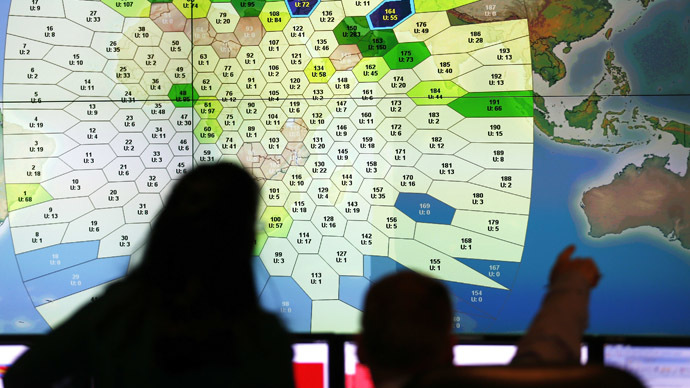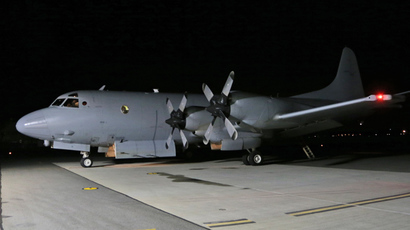Hunt begins to find black boxes for doomed Flight MH370

Now that satellite data has confirmed that the missing Malaysian airliner crashed into the Indian Ocean, the race is on to find the crucial voice and data recorders, the so-called black boxes, before a battery-powered homing device runs out.
After a 17-day wait for confirmation that the Boeing 777, one of the world’s most reliable planes, was lost with 239 people on board somewhere over the southern Indian Ocean, a United Nations search team is working round the clock to try and pinpoint the so-called black boxes.
Malaysian Defense Minister Hishammuddin Hussein said Tuesday that the search area had been narrowed down to an area about the size of Texas and Oklahoma combined.
But Air Marshal Mark Binskin, Australia’s deputy defense chief, issued a sobering reminder of how challenging the search will be.
“We’re not searching for a needle in a haystack – we’re still trying to define where the haystack is.”
The search is made all the more urgent because the battery-powered ping the black boxes emit, a kind of homing signal to help locate them, is only sent out for around 30 days after a crash – before the batteries run out. This leaves another 15 days or so to find them.
But so far the growing international team scouring the southern Indian Ocean has not found any wreckage or debris that can definitely be linked to the plane.

Although British satellite company Inmarsat has said for sure that Flight MH370 went down in a southern corridor of the Indian Ocean and several countries have reported finding floating debris, the exact position of where the plane crashed into the sea is still a mystery.
Eight satellite pings were sent by the aircraft between 1.11 am and 8.11 am – over eight hours after it officially lost contact with air traffic controllers.
The new method "gives the approximate direction of travel, plus or minus about 100 miles, to a track line," Chris McLaughlin, senior vice-president for external affairs at Inmarsat, told Sky News. "Unfortunately this is a 1990s satellite over the Indian Ocean that is not GPS-equipped.”
With a lack of definite information experts in weather patterns and ocean currents will try and direct those scouring the waves to pinpoint where the plane went down.
“We’ve got to get lucky. It is a race to get to the area in time to catch the black box pinger while it’s still working,” John Goglia, a former member of the US National Transportation Safety Board, told AP.
Plan A: Pinger locators from US
The US Navy’s Pacific Fleet is part of the international flotilla amassing over 2,300 kilometers west of Perth, Australia, and one of the Navy’s towed pinger locators is en route to the search area, AP reports.
This crucial bit of kit is a 30-inch long cylindrical microphone, which is towed slowly underwater in a grid pattern behind a ship. It can pick up a ping from a black box – which is actually a red cylinder – from about a mile away.
The microphone is attached to about 20,000 feet of cable and is guided deep underwater by a yellow triangular carrier with a wing span of 3 feet and a shark’s fin on top that looks akin to a stingray.
Human operators and computers on board the ship listen for any signals that may locate the ping.
As well as the towed ping locator, the Australian Navy is sending the ship Ocean Shield to the area, which is equipped with acoustic detention equipment.
Plan B: Sonars to scour seabed
If no strong signals are detected from the black boxes before their batteries run out then the search teams must move to system known as side-scan sonar.
These devises are like sonar used to detect submarines; they send a sound to the sea’s depths and analyze the echo from the seabed to map the ocean floor. They are looking for any abnormalities or unusual shapes on the ocean floor.
The devises can be fitted on unmanned mini-submarines that can dive to the depths of the ocean for up to 20 hours at a time.

Once evidence of debris from the aircraft is found on the seabed, an underwater submersible with a high resolution camera is sent down to visually inspect the area and then using remote control cutting devices and robots pulls the black box out of the wreckage.
Finally, secret intelligence from nuclear submarines may be used, if that can be done without revealing their sophisticated instruments or the location of these clandestine vessels.
Clues in history
Over the past decade there have been crashes similar to the disappearance of light MH370, which may help search teams this time around.
The most obvious is Air France Flight 447, which went down in the middle of the Atlantic, in 2009. It took $40 million, four lengthy search expeditions and a two-year wait before the black boxes were found.
The ensuing data showed that the plane went down mid-cruise largely due to a number of poor decisions by the pilots.
A second example was a Helios jet 737, which lost pressurization and oxygen over Greece in 2005, suffocating the pilot and co-pilot. The plane then flew on autopilot until it ran out of fuel and crashed, but unlike the Malaysian Boeing, it crashed over land and not in one of the deepest and most inaccessible parts of the ocean.














